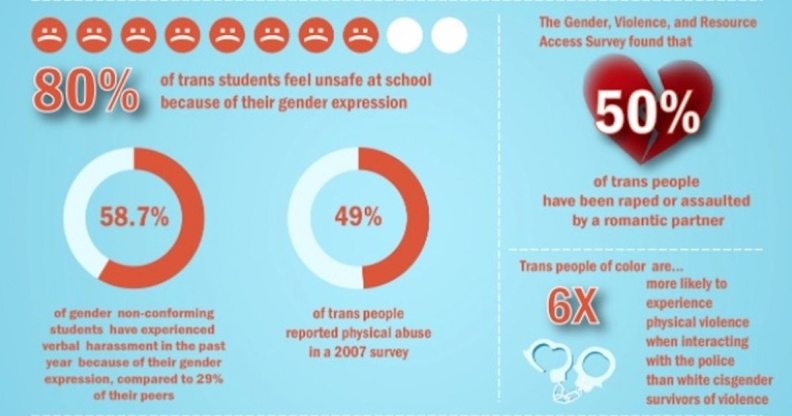This shocking infographic proves why International Trans Visibility Day is so important

International Trans Visibility Day, which takes place on March 31st, is an incredibly important day for the trans community.
It runs alongside – but distinctly separate to – LGBT+ celebrations like Pride, as it seeks to particularly raise awareness to the issues facing the trans community.
Still majorly under represented in mainstream media, trans people are subject to horrific levels of abuse, which when stacked up is shocking reading.
A recent infographic compiled by the TSER, or Trans Educational Student Resources, has laid out the increased levels of violence, threat and fear felt by the trans community.
The infographic below reveals shocking statistics from the trans community.
They include the fact that 80 percent of trans students feel unsafe at school, 50 percent have been raped or assaulted by a romantic partner and 41 percent have attempted suicide.

The statistics of crime and violence against trans people are significantly worse than those of the lesbian, gay and bisexual community, and those questioning their identities.
Then there is the wider issue that the queer community simply cannot be reconciled as one ‘community’ at all.
The academic Eleanor Formby has even said: “I’m not sure that community is a very suitable word for such a diverse group of people.”
Related: Trump’s Defense Secretary Jim Mattis refuses to answer questions about new transgender ban
She insists that “the concept is important but when it is used in the singular, which it so often is, this is not helpful to many LGBT people, not least because not all feel, or wish to be, included within a singular uniform community”.

(Photo by Mark Makela/Getty Images)
“The word community is rarely, if ever, used for people identified as part of majority groups, for example, white community, able-bodied community or heterosexual community, so why do we use it for so-called minority groups?”
Trans Visibility Day founder Rachel Crandall would agree with Eleanor’s argument. In 2009 she created the annual Trans Visibility event to differentiate the struggles of trans people from the rest of the community.
Rachel was born male and faced resistance throughout her young life as she began to present as a woman.
Her message to the Detriot Metro Times recently was: “We must fight!”
“We must flood the White House with letters. We must flood the White House with telephone calls. It doesn’t matter if you do it once, twice, or a million times. Only all together, can we win.”

(Getty)
Related: Donald Trump just banned most transgender people from the military
The chief executive of Stonewall has also said the UK is unsafe for transgender people.
Referring to several backwards steps for trans people over the past year, Ruth Hunt slammed the UK as “unsafe, unwelcoming and frightening place for trans people”.
“Britain is at an absolute crisis point in how it treats trans people,” she said.
In a fiery HuffPost article, the LGBT charity’s CEO wrote that “Britain is no longer considered a safe part of the world for trans people to live in.
“We know from recent Stonewall research just how bad things are if you are trying to get on with your life as a trans person in Britain today.”

